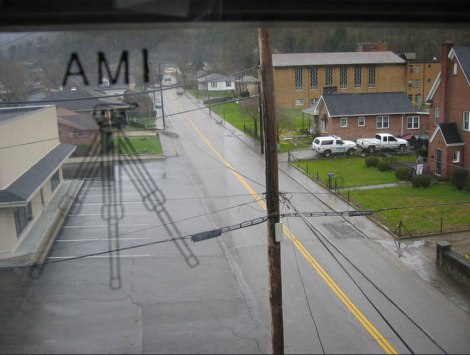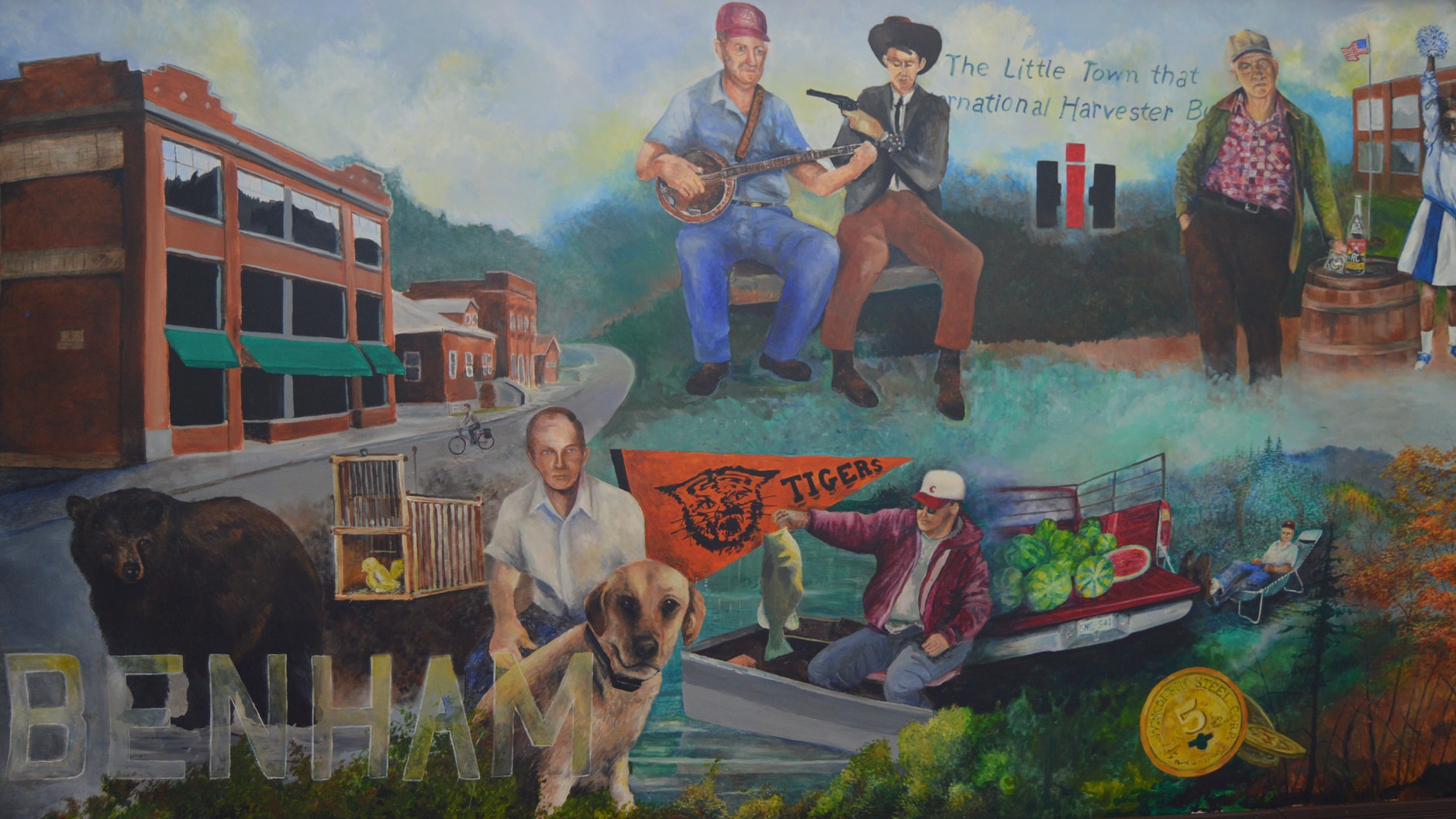Benham, Ky., in the heart of Harlan County, is a quiet place with a proud sign that has been amended over time to read, “Benham, the little town that International Harvester, coal miners and their families built.”
International Harvester, a farm-equipment conglomerate created by industrial speculator J.P. Morgan, bought up Benham’s land and mineral rights soon after the turn of the century in order to supply Wisconsin steelworks with Appalachia’s high-quality coal.
All at once, a trappers’ and hunters’ hamlet became a churning coal-camp town. International Harvester designed the streets, built the houses, attracted the workers, and ran the coal north by rail. Miners were paid good wages when there was work (especially later, when workers were unionized), but most of the workers’ cash went straight back to International Harvester — which owned the two-story department store, the cinema, the hospital, the power company, and every significant business in town.
Half a century later, new machines took miners’ jobs and new technology enabled customers to burn cheaper coal. IH started laying off miners and selling its properties, taking its profits with it — as it had the coal.
Between 1960 and 2012, Harlan County shrank from more than 51,000 residents to fewer than 30,000. Benham’s population (now under 500) set about building a new economy.
Today, the former company store houses a mining museum where visitors can crawl about in a mock mineshaft and study detailed dioramas of life during the boom years. The old public school has transformed into a colorful Country Inn, and there’s a campaign to switch the town power supply (which the town still controls) from coal to renewables.
Unfortunately for Benham, it’s just one of dozens of former coal camps in the area with more coal “heritage” these days than coal. If its population keeps dwindling there won’t be a town here for very long. The town of Lynch, created by another J.P. Morgan-created monopoly (U.S. Steel) sits right next door — with a real mineshaft museum. Similar towns with similar museums exist to the east, in Virginia, and north and south, in Tennessee and West Virginia. The odds of Benham seeing another boom seem stacked against it as steeply as the lush mountains tower over both sides of Main Street.
Not “another America”
A more diverse economy is possible. Before the robber barons arrived, mountains like these produced chestnuts that were sold on the streets of Manhattan and ginseng that was exported to China. Locally tanned leather traveled to South America and Europe.
To begin a new chapter of economic development will require land reform and investment in local people and in local democracy — but it’s possible. That’s the least coal country deserves, says scholar and activist Helen Lewis, who’s lived here for 60 years:
The people who agreed to spend their days digging coal from the underside of mountains produced enough power to industrialize the nation: They’re owed something back.
Lewis moved to southwest Virginia in 1955, just as tens of thousands of miners were moving out. “I was overwhelmed by what was going on,” she recalled last spring. “Mines were being mechanized and half the population was leaving for industrial jobs up north. Strip mining was starting — a whole new form of destruction.”
At the same time, triggered by the exodus, Appalachia was receiving mass media attention — most of it negative. Even as the media expressed concern about poverty (and helped inspire the War on Poverty and programs like food stamps and Medicaid), coverage played into old stereotypes of “backward” hill people with a “culture of poverty” living in what author Michael Harrington called “another America.”
But rather than another America, Appalachia has always offered a reflection of what’s coming down the road for the rest of the country, believes historian Ronald Eller, author of Uneven Ground: Appalachia Since 1945: “Just as Americans in the 1960s didn’t want to address the real structural problems that created conditions in Appalachia (because they hit too close to home) Americans today are equally reluctant to face the more complex systemic problems that we face five decades later.”
In a region so rich, why were the people so poor?
The bellwether
In the 1970s, Lewis was part of a group of scholars and local volunteers who conducted a study of who owned the land. The Appalachian Land Ownership Task Force revealed that absentee owners, primarily coal, timber, and petroleum companies, held title to nearly half the surface area in 80 counties in West Virginia, southwestern Virginia, eastern Kentucky and Tennessee, western North Carolina, and Alabama. According to The New York Times‘ 1981 coverage of the report, individuals and corporations headquartered elsewhere (like Oregon’s Georgia Pacific — now owned by the Koch brothers — and New York’s Pittston Coal) owned 43 percent of the total land area, while only 1 percent of the local population owned tracts larger than 250 acres. Moreover, the Times reported, the volunteer investigators found that three-quarters of the mineral land owners paid less than 25 cents an acre in annual property taxes.
Coal country wasn’t backward — it was being robbed. Total property tax receipts from mineral-bearing land in 12 eastern Kentucky counties amounted to just $1,500 in 1979. “Equitable tax administration” would generate $8 million in those eastern Kentucky counties alone, concluded the report, and a total of $16.5 million more a year in the 80-county study area.
It wasn’t the culture that was the problem, it was the corporations, decided Lewis. “Even at best, mining is exploitative … It leaves little behind unless it is forced,” she wrote. But at the political level, Appalachia’s residents were no match for big donors.
Appalachia wasn’t behind; it was a bellwether.

YES! Magazine graphics by Jim McGowan and Natalie Lubsen. Data from the Appalachian Regional Commission and the U.S. Energy Information Administration.
“It’s a lesson for the whole country,” said Lewis this June. “It’s not just us, a bunch of hillbillies. It’s very much a part of what’s happening all over. The questions here are the questions everywhere: Who owns the place? Where do the profits go? What can people do? Who has control?”
“The issues we face in Appalachia are the issues we face as a globe,” agrees Justin Maxson of MACED, the Berea, Ky.-based Mountain Association of Community Economic Development. It’s true politically and also in terms of energy: “If we can move past fossil fuels here [in the heart of coal country] that changes the debate everywhere” he adds.
Coal heads west
It’s no secret in Appalachia that coal is not the big employer it used to be. After a peak in the late ’90s, coal production in Virginia, West Virginia, Kentucky, and Tennessee is on the decline and national projections indicate that annual production in this region may shrink another 46 percent by 2020, and 58 percent by 2035. Kentucky’s lost some 30,000 coal jobs since 1970, and those that remain (mostly in surface mining and non-union mines), don’t pay what the union jobs underground once did.
While local politicians still resist the idea (it’s hard to find a U.S. Senate candidate in any of these states that doesn’t support Big Coal), this isn’t just another turn in an industry that’s seen many busts and booms. Nationally, production hasn’t declined — it’s moved: from Appalachia, west, to non-union states and overseas. Coal is facing competition from renewables and natural gas (nationally, jobs in solar now outnumber jobs in coal). Environmental regulations, like President Obama’s recently declared limits on carbon emissions from power plants, impose new restrictions and costs on the industry.

Natalie LubsenData from the Energy Information Administration.
Like it or not, Appalachians are increasingly having the conversation that many have seen coming for decades about what happens next. Can the same place that fueled the Industrial Revolution lead us into a new economy? There’s a long way to go, says Maxson. Still, “We are much further along than we were 10 years ago.”
Building a network: a lot of silver BBs
You can’t build a strong local economy without strong local people. But for years, people around here grew up hearing their futures lay elsewhere. “It was like, get your ticket punched and get out,” recalls Herb E. Smith, who grew up in a hillside home above Whitesburg, Ky., with his seven siblings. He’s the son of a miner and the brother of two more.
In Smith’s senior year at Whitesburg High School, two filmmakers from New York showed up to start a media project funded by War on Poverty efforts. It was intended to equip local youngsters with skills they could use to find employment out of state. Invited to make a film about their community, Smith put a camera on his shoulder and started talking to local people about their lives. It was then, he says, that he and his fellow students “fell in love with the place that we were part of.”
In his film work and through the power of his example, Smith has been inspiring people to fall in love with this place and its people ever since. He met his wife, fellow filmmaker Elizabeth Barrett, at Appalshop. The original three-year project has become a 45-year-old nonprofit media arts and education hub that’s been documenting local happenings and training local media-makers since 1969.
Along with making films, the Smiths raised a family. Today, their son Evan is an up-and-coming lawyer in town; daughter Ada returned from university — to stay.
“Being elsewhere made me miss this place,” she said.
“There’s not one silver bullet to replace coal,” says Justin Maxson of MACED. “There are a lot of silver BBs.”
Appalshop is one of those BBs. The ground floor of the organization’s sunlit, former-warehouse home features an art gallery for local artists and a community theater, as well as a community-run radio station with a window onto the street. Editors and administrators work upstairs. A state-of-the-art vault for archives just opened in the basement — the only climate-controlled media depository in the state.
Last year, at 26 years old, Ada Smith became Appalshop’s development director. She’s also a founding member of the Stay Together Appalachian Youth (STAY) Project a youth-led, multi-issue network. Her mission, she says, is “to build and keep wealth—and young people— here.” Critical to that mission is creating an ecosystem of knowledge and experience.
Appalshop offers local residents a chance to learn skills, take leadership, and develop projects — some of which, like the vault, have the potential to make money. The organization’s doing development work; it’s also doing the critical cultural work of changing the image outsiders have of Appalachia, and that Appalachians have of themselves.
The shelves of Appalshop’s basement vault are piled high with decades of productions in every format imaginable: shiny tin reels, fat and thin videotape, digital drives of every size. The archives hold the stories of coal workers and country singers and kids, parents, and grandparents talking about their lives.
“We’ve been through people elsewhere telling us what to do,” says Herb. “We’ve had a lot of experience of how that fails.” Now people here have a chance to do something different, but transitioning to an economy that’s not so top down is not going to be easy. The coal industry didn’t just over-exploit the coal here, says Herb. It underdeveloped the skills of the community.

Colin MutchlerWhitesburg through the windows of Appalshop.
“In functioning economies, the local people participate,” he said. “Jeffersonian democracy isn’t about there being some company that comes up here and builds your house.”
Appalshop is a success story. Founded 45 years ago with a federal grant that soon ran out, Appalshop now supports 27 workers, bringing in money through grants but also through the sale of its videos and media services to clients in this country and around the world.
Making that many jobs in a county this size makes Appalshop an economic force. They’re here in the coalfields, meeting payroll every two weeks. “We’ve demonstrated that it’s possible,” says Herb, a satisfied smile broadening beneath his bushy white moustache.
[youtube https://www.youtube.com/watch?v=emXKXPfMf7s&list=PLF3C4693102708BBB]View more videos from Appalshop’s YouTube Channel
Appalshop pumps a certain amount of money into the local economy through wages and spending. Even more significant is its catalytic effect on other businesses and the town.
Amelia Kirby is the co-owner of Summit City, a bar/café/music venue in the center of town. She used to be the hip-hop DJ on Appalshop’s radio station, WMMT. Almost seven years ago, Kirby and her partner created half a dozen jobs (and a bit of a stir) when they became the first business in Whitesburg to sell alcohol after the town council was persuaded to roll back its prohibition-era “dry” ordinance. Summit City got attention because it was able to book big-name bands, and it could book those bands in part because of the live radio studio down the road at Appalshop. Artists who might otherwise never have come to so small a venue know they’ll be heard for miles around.

Jason VowelsLive music at Summit City.
While it’s not in the black yet, Kirby’s happy with the impact the café is having on the community. The town center is not as quiet after 5 p.m. as it used to be, she says. And people who have been bitterly divided over issues like coal mining are meeting over music and drinks.
Still, in Maxson’s terms, there’s a long way to go to make systemic change. If Appalshop and Summit City are two silver BBs, they haven’t hit their target yet. Letcher County, where Whitesburg sits, has a slightly smaller population than Harlan and a slightly lower poverty rate, but it’s still hard up (one in four, instead of one in three, residents live in poverty).
Appalshop still relies on foundation grants, and Kirby and her partner subsidize the café from other funds. To become self-sustaining, local changemakers need state level partners capable of changing policies, increasing tax revenues, and building infrastructure and demand sufficient to bring local initiatives to scale. And because the coal industry penetrated so deeply into every aspect of local life, Appalachia needs a lot of change all at once.

Catherine Moore / Appalachian Transition FellowsInside WMMT, Appalshop’s flagship radio station.
A local vision for transition
Replacing coal in coal country is like rewiring a state-sized home. From elections to electricity, the coal economy penetrated every system. Without coal, Appalachia needs not just energy change but systemic change and economic development of massive proportions.
Fifty years after the War on Poverty, the Appalachian Commission reports that the region’s residents receive less federal funding per head than their more affluent East Coast neighbors. That doesn’t look as if it’s about to change.
Still, the area has been targeted for special assistance from the federal government under President Obama’s Promise Zone project — a White House initiative to get certain hard-up areas priority access to existing government programs. And in Kentucky, a bipartisan state initiative called SOAR (Shaping Our Appalachian Region) has been tasked with coming up with models for development.
At the end of April, Whitesburg hosted a “listening session” for residents seeking to weigh in on the county’s plan. Asked to list the “assets” of the region, some of the 75 or so participants put the area’s culture and land close to the top. Others listed natural resources, timber, gas, and the remaining coal. Discussions immediately broke out between the group who feared that pollution from further mining or drilling would wreck the rivers for rafting and canoeing, and the group who doubted service jobs could support a strong local economy.
David Fisher was laid off in 2012, after a lifetime in the steel industry, when the company he worked for was bought by a conglomerate and promptly closed. “Seventy-eight of us were sent home that same day,” he says.
Since then, Fisher and his wife started a general store in Whitesburg, selling everything from paper towels to handmade quilts. But foot traffic is slow. A former engineer, Fisher can name half a dozen needs in the area that are going unmet: everything from the means to wire wind turbines to the grid, to a slaughterhouse for local livestock farmers.
Rather than attempting to attract tourists or chain stores in from elsewhere, Fisher would like to see better broadband, more technical assistance, and easier-to-get loans to local entrepreneurs.
“It’s not as simple as go work for somebody else,” Fisher told me. “If we want to work we better create our own jobs.”
In the meantime, Fisher supplements his family’s income by selling produce at a new local farmers market. Valerie Horn, a retired high school guidance counselor (who, as a child, participated in one of Appalshop’s first oral history projects) works with the Community Farm Alliance. The Alliance encourages local people to grow more of their own food and helps people like the Fishers earn income from their gardens. Last year, with help from a state university and the local community college, she was part of a group that started the farmers market, attracting 10 to 12 sellers. She expects twice that many to take part this summer.
“I’ve not seen this much enthusiasm about anything in a long time,” Horn said over lunch with Kirby, Smith, and Fisher, before the listening session. “That $300 or $400 that people bring in a month from the market is the difference between leaving and being able to stay in their homes.”
On the questionnaire distributed at the meeting, Horn suggests a local bottling and canning plant so local growers can sell their produce over a longer season. She also expresses skepticism. When asked, “What are the obstacles the region and your county have to overcome to move forward?” Horn wrote: “The local elite has decided the county priorities without any planning [and with] little community input.”
Horn’s fear is common. While venerable local groups like KFTC, the Farm Alliance, or the American Chestnut Foundation (which plants trees on reclaimed mining land) have spent decades promoting diversification, bottom-up development, and the reforesting of clear-cut lands, state and federal funds have typically gone to shopping malls, industrial parks, golf courses, and prisons. You can see them, sitting on concrete slabs — some busy, some pretty empty — on flattened mountain land across coal country.
The most influential U.S. Congressman in the state is lobbying hard for more of the same. With two sites identified not far from Whitesburg, Hal Rogers (R-K.Y.) has already secured millions of dollars in congressional aid for planning new prisons. The chair of the powerful House Appropriations Committee, Rogers is also involved in a bipartisan state initiative called SOAR. Sylvia Ryerson, who works on a prison project at Appalshop, fears that any new aid that comes this way will be snapped up by Rogers for prisons.
This is a critical time, she says, “when the only plan we’re being offered from above is a high-security prison with no guarantee of local jobs. We need to look to each other for ideas.”
From mines to wines: Models for economic transition
Coal isn’t the first toxic industry to dominate the Appalachian economy. In the rural areas of the region, the tobacco industry once seemed untouchable, too — until a series of successful lawsuits hobbled it.
“If transition from tobacco was possible, then so is transition from coal,” West Virginia farmer and local food activist Anthony Flaccavento said as we sat at the big farmhouse kitchen table overlooking his organic vegetable farm.
After losing in court on charges of covering up the dangers of smoking, the biggest tobacco companies in the world agreed in the 1990s to a “Tobacco Master Settlement Agreement.” Thanks to vigorous local organizing, some of the more than $206 billion states received went to family tobacco farmers seeking to switch to other crops. Those reparations not only helped people whose lives had been ravaged by cancer, but also family farmers whose livelihoods were tied up with tobacco.
Big Coal has yet to be forced into any “settlement” comparable to Big Tobacco, even though tens of thousands of miners have suffered ill health as a result of poorly protected work underground, and entire communities have felt the harmful effects of coal and the related chemical industry.
Having felt no threat, some of the same global energy companies and absentee land owners identified in the Appalachian Land Use Study of the ’70s still have huge influence today (the Koch brothers’ Georgia Pacific is one). Some companies that once mined coal are now turning to gas. Fat pipelines already snake across people’s land. The wages aren’t as good and the environmental impacts are still bad, but ex-miners are being told their coalfield skills will transfer well to drilling. Local activists were recently able to delay a proposed “BlueGrass Pipeline” planned to pass through Ohio, Kentucky, and West Virginia, but more are on the way.
Forcing coal companies to pay out now has the potential to slow down or stop the next wave of extraction. While national groups, when they talk about coal, tend to emphasize the negative environmental impacts of burning it, local organizations like Coal Mountain River Watch, the Ohio Valley Environmental Coalition, and the ACHE campaign are laser-focused on corporate crimes in the extraction process. And a cohort of (mostly local) lawyers are pushing cases through the courts. Big Coal’s not off the hook yet. Far from it.
In the meantime, local landowners like David Lawson are making the best out of a bad situation. Lawson is the co-owner and founder of Mountainrose Vineyard in Wise County, a winery in the heart of coal country. The grandson of coal miners and the inheritor of land that’s been in his family since the mid-1800s, Lawson planted his first vines in 1996 on land that had been strip-mined in the 1980s. (While his family owned the land, the coal companies owned the minerals beneath it.) The Lawsons were able to arrange for the company to leave their property, which had been steeply graded — just right for grape-growing.
Lawson calls it a story of “mines to wines.” Now his wines, with names like Jawbone and Pardee (named after coal seams), are winning prizes and Lawson believes his business could grow.
“My grandfathers were coal miners,” Lawson said this June. “They dug coal where we are growing grapes today. It’s our way of honoring our heritage as we move into the future.”
Unfortunately, today most of Wise County is still owned by the federal government and the coal companies — and the companies won’t lease their land for more than a year at a time. “That’s OK for grazing cattle, but it’s no good for wine growing,” Lawson said.
Short of forcing the companies to give up their land, the authorities could offer the coal companies tax incentives to lease it out for the long term. Lawson believes county coffers would see a boost from business revenues and the community would benefit too.
I asked Lawson, what if Wise County became award-winning wine country?: “That would create more name recognition worth than any amount of development dollars — and give the county a new image.”
“That man could be anybody’s”
Legal strategies may yet play out. In the meantime, there are other possibilities at the level of policy. At a conference of the Appalachian Studies Association held in Huntington this spring, scholars and activists compared their situation to others they felt were comparable: When military bases close, for example, the federal Base Realignment and Closure process sometimes helps military communities transition to a different economy.
Across the Atlantic, coal communities in Wales received millions of pounds from the European Commission to develop biotechnology and green energy alternatives. Industrialized shortly before Appalachia, now Wales promotes itself as a green energy leader.
No one has done more to raise questions like these and connect Appalachian mining communities with those in other parts of the world than Helen Lewis. This year she is turning 90. Still in coal country, she lives in a cooperative elder housing community in southwest Virginia where every inch of wall space in her welcoming bungalow home is decorated with paintings, carvings, and ceramics celebrating life in coal mining places. They are gifts from friends she’s made and exchange trips she’s arranged — from other coal-mining communities in Appalachia, to Wales and Chile and South Africa, among others.
Her back is more bent than it used to be, but her passion isn’t flagging. These days, she has plenty of company in her belief that local people rooted in their history and culture need to be at the heart of the region’s reinvention.
When we met in the spring of 2012, Lewis was just back from a conference convened by Kentuckians for The Commonwealth titled “Appalachia’s Bright Future.” She was particularly fired up about apple trees. She said before industrial mining, Virginia was the largest apple producer in the United States. She sees a bright future in heirloom fruit, hard cider, and apple wine.
“Bring back the orchards,” Lewis told a public meeting in nearby Norton this April. It made the front page of the local newspaper.
When I ask her what she’ll miss about coal, Lewis’ blue eyes glint: “I’ve never known closer, more caring communities.” Her comment takes me back 25 years to a strike I covered in Virginia in 1989. When Pittston Coal, then the leading coal producer in Virginia and the second-largest exporter in the United States, sought to cut the health benefits of its retirees, the reaction in coal country was immediate. Miners and their families — and just about every shopkeeper, chaplain, and contractor around — took their turn blocking coal traffic entering or leaving the coal-pit gates. Those that didn’t blockade massed around in the dusty streets to cheer them on.
Since people’s lives are constantly at stake, coal-mining communities have developed a culture of hanging together. “Everyone is listening for the siren [the alarm that signals an accident down the mine],” Lewis reflected. If a single man was trapped underground, everyone in the town waited at the pit-head until he surfaced — because, as she put it, “that man could be anybody’s.”
I ask her, “Can we create strong, local economies and caring communities without the destruction of coal mining?”
“That’s the question,” she responds.
Appalachians are not the only ones whose fate hangs on the answer.
Natalie Lubsen, Molly Rusk, and Jim McGowan contributed reporting and graphic design to this article.





